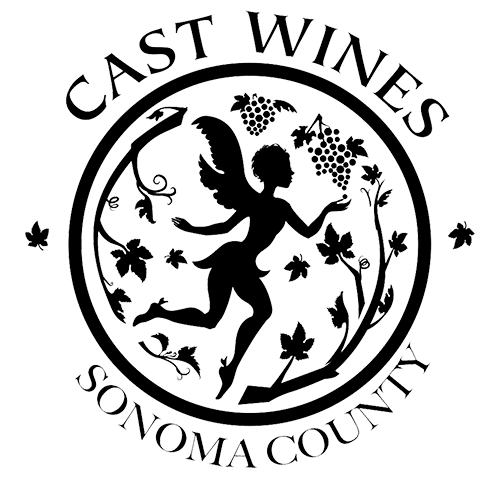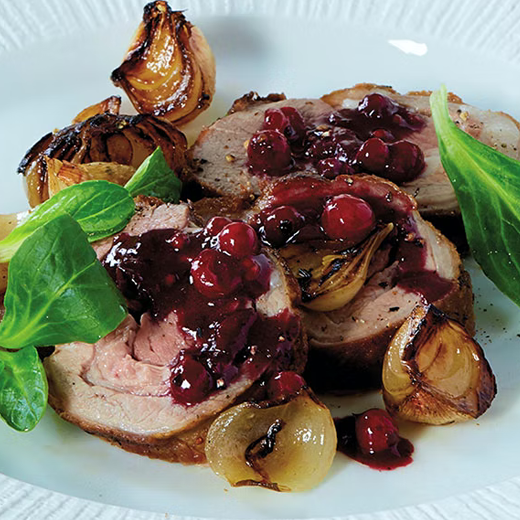Lamb Loin with Pinot Noir
Chef Dustin Valette of Valette in Healdsburg, Calif., tailors this dish to the wine by adding a summery sauce of fresh red currants. Plus get the chef’s recipe and cooking tips. By Hilary Sims
Recipe courtesy of chef Dustin Valette and tested by Wine Spectator’s Julie Harans. Photo Credit Lucy Schaeffer
Ingredients
- 12–15 cipollini onions, unpeeled, rinsed and dried
- Extra-virgin olive oil
- Sea salt
- Freshly cracked black pepper
- 1/2 bunch (about 15 sprigs) fresh thyme
- 2 pounds boneless lamb loin, sinew removed, fat scored 1/4-inch deep, rolled and tied with kitchen string, if needed for even cooking
- Leaves of 3 sprigs fresh rosemary, chopped
- 2 whole cloves garlic, peeled
- 6 tablespoons unsalted butter
- 2/3 cup fresh red currants, stems removed (may substitute frozen, unthawed or thawed)
- 1 bottle red wine (3/4 cup is for cooking; the rest is for you to drink!)
- 8 pieces lamb’s lettuce (or purslane, mâche or butter lettuce)
Directions
Preparation
1. Preheat oven to 350° F. In a small bowl, drizzle the onions with olive oil, sprinkle with salt and pepper, drizzle with 4 tablespoons water and add the thyme. Toss to combine. Place in a medium-size casserole dish or Dutch oven, cover tightly with aluminum foil and roast until tender, about 40 to 45 minutes. Remove from oven and let cool slightly. Remove the skin. Cut in half horizontally and set aside.
2. Drizzle both sides of the lamb with olive oil, and season with salt, pepper and rosemary.
3. Heat a large, heavy stainless-steel pan over high. When the pan is hot, add the lamb, fat side down. This will get smoky; be sure to have your vent fan on. Cook until golden-brown, about 3 minutes. Flip and sear the other side until golden-brown, about 3 minutes more. Add the garlic cloves and half the butter to the pan. Cook for about 10 minutes, flipping the meat halfway through and using a large spoon to baste the lamb frequently with the butter as the butter turns golden-brown. When the lamb is cooked through (an instant-read thermometer should register 130° F), remove from the heat and transfer to a platter. Reserve in a warm spot.
4. Drain the excess fat and the garlic from the pan and set over medium-high heat. Add the cooked onions, sautéing until golden-brown, about 1 to 2 minutes. Transfer to the warm platter with the lamb.
5. With the pan still over medium-high heat, add the currants and sauté until the berries start to pop. Add 3/4 cup wine and reduce with the currants until 80 percent of the liquid has evaporated, about 5 to 7 minutes. Slowly whisk in the remaining butter over the heat until fully incorporated. Season with salt and pepper to taste.
6. Slice the lamb into medallions. On each dinner plate, place some onions in the center. Put a couple pieces of lettuce on one side. Place a few lamb slices on top of the onions. Spoon the currant sauce on the lamb and around the plate. Serves 4.
Chef’s Notes
Fresh red currants add a tart burst of summertime to this otherwise savory, roasty herbed lamb dish. With a big splash of red wine and a pat of butter, the berries cook down to become a jamlike sauce literally made for pairing with red wine. Here, Valette shares his tips on how to make the dish really shine.
- To cook with the good wine, or not to cook with the good wine? On the ever-controversial topic of whether to cook with the wine you’re drinking or instead use a “lesser” bottle, Valette says the answer varies. He’d never cook with a rare or extremely costly bottle (holster that 1982 Mouton-Rothschild), but better-quality wine does sometimes beget better-quality food, particularly if the recipe calls for a fairly large quantity of it, or if the wine is not cooked (such as in oysters with a splash of Champagne), in which case the flavors and texture of the wine will be more apparent in the food.Because this recipe calls for a good 3/4 cup wine, the tannins and acidity of a well-structured Pinot will actually help balance the sauce. But if you can’t bear to divert that much fine wine away from your glass and into the saucepan, that’s OK; it’s unlikely anyone will notice or care if you choose to use a middling-quality bottle instead. Just be sure it’s something you wouldn’t mind drinking. (If you do use a more modest wine for cooking, you can always freeze the leftover wine in ice cube trays for later cooking use—just don’t expect it to be drinkable on its own after freezing.)
- This recipe is more hand-painted treasure map than architectural rendering. Except with baking, which requires precision, the truth is that most recipes are open to a measure of interpretation through the lenses of personal preference and market availability. Valette says this is definitely one of those recipes. “It’s a direction. It’s an idea. It’s like an old-school treasure map,” he says. “It doesn’t say longitude and latitude. It doesn’t say, ‘Go exactly 147.3 feet from this exact coordinate.’ Instead, it’s a dot-dot-dot around the tree, around the rock, by the beach, over here is the treasure.” This doesn’t mean you shouldn’t follow the recipe if you like doing that, but it’s also OK to feel it out.
- Even so, know your True North. Valette believes in following the ingredients. Within reason, choose items at the market for their quality over their fidelity to the recipe. If your market’s cipollini onions look unappetizing but the pearl onions are smooth and fresh, get the pearl onions; they’re quite similar and more widely available. If you can’t find fresh currants, or the ones at the market aren’t great, a good alternative would be individually quick-frozen (IQF) ones in the freezer aisle. If you can’t find frozen currants, fresh tart cherries would work—just pit them before cooking. “You can’t take yourself super-serious,” Valette says. “End of day, it’s kind of all the same … -ish. It’s just, how many nuances do you want to stack to make it the most epic bite ever?”


